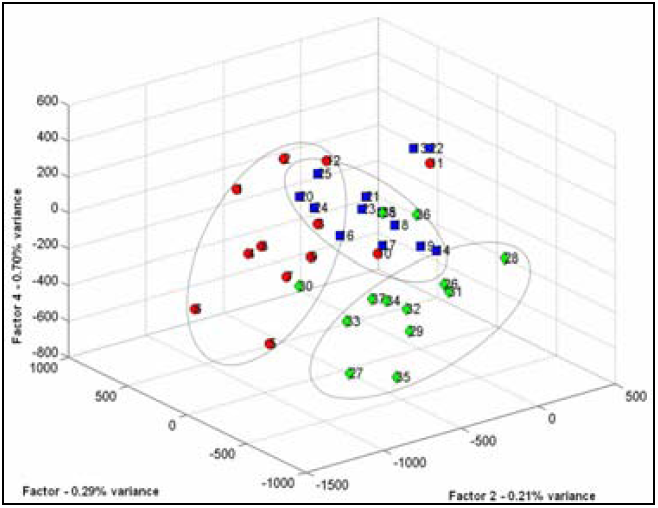94.
Ribeiro F. A. L., Monteiro V. F., Longo E., Ferreira M. M. C., "Quantitative
Discrimination of AFM Images of Human Hair from Different Ethnic Groups:
African, Caucasian and Oriental". Águas de Lindóia, SP,
Brazil, 10-15/09/2006: 10th International Conference on Chemometrics
in Analytical Chemistry (CAC-2006, CAC-X), Book of Abstracts
(2006) P085. Poster 085.
10th International Conference
on Chemometrics in Analytical Chemistry P085
Quantitative Discrimination
of AFM Images of Human Hair from
Different Ethnic Groups:
African, Caucasian and Oriental
Fabiana Alves de Lima
Ribeiro1*, Valéria Fernandes Monteiro2,
Elson Longo2, Márcia
M. C. Ferreira1
fabianaalr@yahoo.com.br
1. Laboratório
de Quimiometria Teórica e Aplicada, Instituto
de Química, Universidade Estadual de
Campinas (UNICAMP), Brasil.
2. Laboratório Interdisciplinar de Eletroquímica e
Cerâmica, Instituto de
Química, Universidade
Federal de São Carlos (UFSCAR), Brasil.
Keywords: Image Analysis,
Human Hair, Discriminant NPLS, Atomic Force Microscopy
_____________________________________________________________________________________
Purpose.
The human hair is a complex tissue consisting of several
morphological components. The
physical integrity
of the fiber and the major physical and chemical characteristics
are determined mainly
by the three most important
constituents acting together: cuticles, cortex
and intercellular components.
The ethnic aspects of human
hair are resulting from the differences in
the constitution of theses three
components,
and they are reflected in the characteristical
aspect of the fiber surface1.
Quantitative
methods to identify
and classify such characteriscs could be very useful
to cosmetic science, forensic
investigations and medical
diagnosis.
Method.
This work presents a quantitative method to discriminate
images of human hair fibers from
three ethnic groups:
african, caucasian and oriental, based on the utilization
of a multi-way partial least
squares (NPLS2)
technique. The samples were colected from the root end area,
where the fibers are
yonger and most preserved
from effects of combing, weathering and cosmetic action. Samples of human
hair were obtained from
De Meo Brothers, New York, USA. Atomic Force Microscopy (AFM) images were
obtained using a
Digital Instruments NanoScope IIa instrument, under atmospheric
conditions at 25°C
and a loading force of 3.6
nN.
 Results.
The data
set consists of a 3D array X (38 x
Results.
The data
set consists of a 3D array X (38 x
256
x 256) where the 38 pixels images (256 x
256)
are
superimposed, and a bidimensional array Yij
(38
x
3), where yi1
= caucasian fiber, yi2 = african
fiber,
yi3
= oriental fiber. Discreete categorical values of 0
and
1 were attributed to each column, in which 0 =
samples
that don´t belong to that category and 1
=
means
the opposite. The X array was submitted to a
logarithmic
transformation3
and it was modeled
using
NPLS. The best results were obtained without
any
further preprocessing and 4 latent
variables
were
necessary to describe 88.21% on the
total
variance
of the X block and 66.29% on
the total
variance
of the Y block. Figure 1
presents the
distribution of samples
in the LV1 x LV2 x LV3 loading plot, where (circles) african,
(squares) caucasian
and (diamonds)
oriental. The hair fibers surface are quite irregular
and present very heterogeneous
aspects as intrinsic
characteristic. The samples are well clustered in specific
areas although a few of
them occupy the intermediary
regions.
Conclusions.
The Discriminant NPLS model allowed to discriminate the 3 classes
of samples with
success, and it can
be used succesfully for classification and discrimination of greyscale
images.
Acknowledgments.
F.A.L.R. and M.M.C.F. greatfully acknowlegde financial
support from FAPESP
and CAPES. V.F.M.
and E.L. greatfully acknowlegde financial support from
FAPESP and the CEPID
Program and CNPQ.
__________________________________________________________________________________________________________________________
References
1 Robbins, C.
R., Chemical and Physical Behavior of Human Hair (3rd edn),
Springer: New York, USA,
1994, 1-92.
2 Bro, R. J.
Chemometrics 1996, 10, 47-62.
3 Huang, J.,
Wium, H., Qvist, K. B., Esbensen, K. H. Chemolab 2003, 66,
141-158.
 Results.
The data
set consists of a 3D array X (38 x
Results.
The data
set consists of a 3D array X (38 x